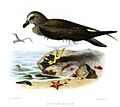Magenta petrel facts for kids
Quick facts for kids Magenta petrel |
|
|---|---|
 |
|
| chick | |
| Conservation status | |
| Scientific classification | |
| Genus: |
Pterodroma
|
| Species: |
magentae
|
The magenta petrel (Pterodroma magentae), also called the Chatham Island tāiko, is a special type of seabird. It's part of a group of birds known as gadfly petrels. This amazing bird lives only on Chatham Island in New Zealand. It is one of the rarest birds on Earth! For over 100 years, people thought it had disappeared forever. But luckily, it was found again in the 1970s.
Contents
What Does It Look Like?
This medium-sized petrel has a brownish-grey head, neck, and upper chest. Its belly and the underside of its wings are white. The bottom of its wings are brown. It has a black beak and pink legs. Adult birds usually weigh between 400 and 580 grams.
Life Cycle and Habits
These birds build their nests in long burrows, which are like tunnels, under thick forest. These burrows can be 1 to 3 meters (3 to 10 feet) long. Magenta petrels form strong, lasting pairs. They lay only one egg at a time. Both the mother and father bird take turns sitting on the egg to keep it warm. They also both feed the chick once it hatches. The breeding season for these birds is from September to May. During this time, they fly far out over the open ocean to find food.
A Look Back in Time
Old bones and historical records show that tāiko birds used to be very common on Chatham Island. They were the most common seabird that dug burrows there. However, they have not been found on any other islands. The Moriori people, who are the native people of the Chatham Islands, used to collect tāiko and other birds for food. We know this because tāiko bones have been found in their old rubbish piles.
The very first magenta petrel specimen was collected on July 22, 1867. It was found by a ship called Magenta in the South Pacific Ocean. This was halfway between New Zealand and South America. The name 'Magenta petrel' and its scientific name P. magentae both come from this ship.
People thought the tāiko had been extinct for 111 years. But in the 1970s, a conservationist named David Crockett started looking into reports from local people who said they had seen the bird. On January 1, 1978, Crockett actually caught a tāiko! It took another ten years to find a tāiko burrow. This discovery proved that the live birds were indeed the same species as the one found by the Magenta ship.
Helping the Taiko Survive
The tāiko used to live all over Chatham Island. Now, it only lives in the forested Tuku Valley in the southwest part of the island. This species is one of the rarest birds in the world. It is often called the world's rarest seabird. The tāiko is listed as critically endangered. This means its population has dropped by more than 80% in the last 60 years. Also, it lives in only one small area. In the 2005 breeding season, there were 13 known breeding pairs. They successfully raised 11 chicks. Today, there are estimated to be only about 80 to 100 adult birds left.
The biggest dangers to the tāiko are animals that were brought to the island by humans. These are mainly cats and rats. Feral pigs also cause problems by collapsing the burrows where the birds live.
The land where tāiko were first found again was owned by Manuel and Evelyn Tuanui. In 1983, they gave 1283 hectares (about 3170 acres) of their land to the government. This was done to protect the species. This land became the Tuku Nature Reserve. In 2004, about 80 percent of tāiko breeding burrows were found in this reserve. The Tuanui family also helped start the Chatham Island Taiko Trust. This group works to protect the tāiko.
There is a special plan to help the tāiko. It involves moving young chicks to a safe area called the Sweetwater Secure Breeding Site. In this area, the main dangers have been removed. Studies of other seabirds show that birds usually return to the place where they learned to fly. In 2007, eight chicks were successfully moved and grew up in this safe breeding site. Since 2006, a special fence has been built around a small area of land to keep predators out. So far, 60 tāiko have been moved to this protected area.
Images for kids
See also
 In Spanish: Fardela taiko para niños
In Spanish: Fardela taiko para niños



